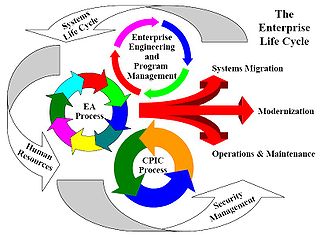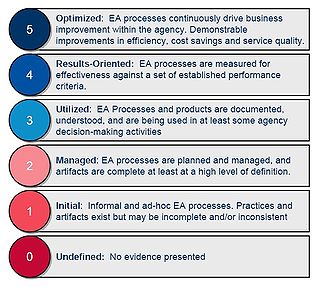This article needs additional citations for verification .(October 2009) (Learn how and when to remove this template message) |
Segment architecture is a detailed, formal description of areas within an enterprise, used at the program or portfolio level to organize and align change activity. [1]
Contents
It defines a simple roadmap for a core mission area, business service, or enterprise service. Segment architecture is driven by business management and delivers products that improve the delivery of services to citizens and agency staff. From an investment perspective, segment architecture drives decisions for a business case or group of business cases supporting a core mission area or common or shared service. The primary stakeholders for segment architecture are business owners and managers. Segment architecture is related to Enterprise architecture (EA) through three principles:

Management is the administration of an organization, whether it is a business, a not-for-profit organization, or government body. Management includes the activities of setting the strategy of an organization and coordinating the efforts of its employees to accomplish its objectives through the application of available resources, such as financial, natural, technological, and human resources. The term "management" may also refer to those people who manage an organization.
A business case captures the reasoning for initiating a project or task. It is often presented in a well-structured written document, but may also come in the form of a short verbal agreement or presentation. The logic of the business case is that, whenever resources such as money or effort are consumed, they should be in support of a specific business need. An example could be that a software upgrade might improve system performance, but the "business case" is that better performance would improve customer satisfaction, require less task processing time, or reduce system maintenance costs. A compelling business case adequately captures both the quantifiable and non-quantifiable characteristics of a proposed project.
Enterprise architecture (EA) is "a well-defined practice for conducting enterprise analysis, design, planning, and implementation, using a comprehensive approach at all times, for the successful development and execution of strategy. Enterprise architecture applies architecture principles and practices to guide organizations through the business, information, process, and technology changes necessary to execute their strategies. These practices utilize the various aspects of an enterprise to identify, motivate, and achieve these changes."
- Structure: segment architecture inherits the framework used by the EA, although it may be extended and specialized to meet the specific needs of a core mission area or common or shared service.
- Reuse: segment architecture reuses important assets defined at the enterprise level including: data; common business processes and investments; and applications and technologies.
- Alignment: segment architecture aligns with elements defined at the enterprise level, such as business strategies, mandates, standards, and performance measures.
A business process or business method is a collection of related, structured activities or tasks by people or equipment which in a specific sequence produce a service or product for a particular customer or customers. Business processes occur at all organizational levels and may or may not be visible to the customers. A business process may often be visualized (modeled) as a flowchart of a sequence of activities with interleaving decision points or as a process matrix of a sequence of activities with relevance rules based on data in the process. The benefits of using business processes include improved customer satisfaction and improved agility for reacting to rapid market change. Process-oriented organizations break down the barriers of structural departments and try to avoid functional silos.










